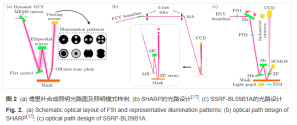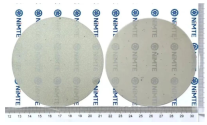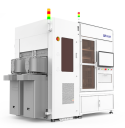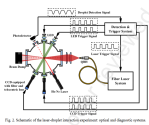Mask defects characterization techniques based on synchrotron radiation extreme ultraviolet light source
Abstract
The multilayer structure of extreme ultraviolet (EUV) masks limits the penetration depth of traditional inspection techniques at non-working wavelengths, thus hindering the effective examination of buried phase defects. Developing defect characterization techniques operating at the 13.5 nm wavelength is crucial for overcoming the quality bottleneck in EUV mask fabrication. Synchrotron radiation light source, with their stable EUV wavelength, cleanliness, and high power density, represents an ideal light source for EUV mask defect characterization research. In this work the current state of technology development for mask characterization at the world's four major synchrotron radiation facilities are systematically reviewed. Through comparative analysis, their working principles, technical advantages, and limitations are investigated in depth, and provide a forward-looking discussion on future trends. In response to the specific requirements for EUV mask defect detection and review, this paper discusses the requirements for the next-generation system platform, which integrates deep detection and review functions,
develops novel compact light sources, and innovatively combines the advantages of various imaging techniques to improve the numerical aperture (
NA ) of imaging systems. This aims to achieve a theoretical resolution of over 20 nm, meeting the future demands of the EUV lithography industry for higher
NA (>0.55) and shorter wavelengths (6.7 nm). Regarding the prospects of extending synchrotron radiation to industrial applications, a compact synchrotron radiation source, which can be developed on-site in semiconductor facilities, is introduced to accelerate the research and development cycle, while achieving the synergistic integration of imaging technologies. This paper focuses on the application of phase recovery principle of ptychography to Fourier synthesis illumination (FSI), achieving aberration correction in lens-based systems through synthetic aperture extension. In this paper, the working principles, performance benchmarks, technical challenges, and emerging development trends of existing synchrotron radiation-based EUV mask characterization techniques are investigated. It provides an important reference for designing next-generation EUV mask characterization system platforms.

SSRF-BL09B1A
SSRF built an integrated system platform for online detection and analysis of EUV mask defects, SSRF-BL09B1A, on the BL09B beamline, covering an energy range of 80-500 eV. Its configuration includes two grating monochromators with line densities of 50 l/mm and 250 l/mm, which can achieve energy resolutions
E /ΔE
( 92 eV) of approximately 1000 and 8000 respectively [
2 ,
3 ] to meet the imaging requirements of zone plates
with different NAs . As shown in Figure 2(c), the optical path design of SSRF-BL09B1A is similar to that of SHARP, that is, it uses the same three-mirror FSI system, and can also focus the EUV beam onto the mask surface by 10 times. Unlike SHARP, SSRF-BL09B1A additionally uses an SCMOS detector to directly collect the dark field signal of the mask reflected light, and can use dark field spatial correlation spectrum technology to quickly find and locate the suspected defect location, and realize the online detection function [
27 ] . When the defect-free area of the mask is exposed, SCMOS only acquires zero-order light, i.e., the bright field signal; when a defect is exposed, SCMOS also acquires weak diffraction signals outside the zero-order light region, i.e., the dark field signal. Since the defect size is in the tens of nanometers, the dark field signal is very weak compared to the millimeter-sized light spot at the mask. Therefore, to improve sensitivity, spatial correlation calculations need to be performed on the nearby dark field signals. When a defect appears, observing the abrupt change in the correlation spectral function value can quickly identify the suspected location of the defect.
The analysis section of SSRF-BL09B1A still uses off-axis zone plates to amplify the mask reflected light to CCD for full-field imaging. Based on the three-mirror FSI system to form a large
NA angle, the illumination conditions with arbitrary filling patterns can be achieved through programming
, as shown in Figure 2(a). At the same time, by configuring off-axis zone plates with different
NAs , the analysis of the located defects can achieve a theoretical resolution of better than 20 nm [
27 ] . To date, for a 6-inch EUV mask, the defect analysis resolution of SSRF-BL09B1A using an off-axis zone plate with 4×
NA = 0.5 and single coherent illumination has reached 48 nm hp. In the future, an off-axis zone plate with 4×
NA = 0.625 and FSI will be used for further optimization.
Compact Accelerator Light Source
Although synchrotron radiation EUV light sources have advantages such as stable wavelength, cleanliness and pollution-free operation, and tunable wavelength, their facility dependence and time cost are still bottlenecks for industrial applications. Therefore, compact accelerator light sources with small size have attracted the interest of some international research institutions and commercial institutions. For example, the PAL-EUV device built by the Pohang Accelerator Laboratory (PAL) in South Korea in 2022 has generated EUV light with a beam energy of 400 MeV in size of only 11.5 m × 11.5 m [
5 ] . However, the external facilities of PAL-EUV are too large, with a main ring circumference of about 40 m and an area of more than 130 m2 [
5 ] , which is not conducive to industrial applications.
PSI proposed a compact low-emissivity accelerator design, namely the compact storage ring for actinic mask inspection (COSAMI) [
6 ] . To resolve the conflict between compactness and low emissivity and to maintain high beam brightness, COSAMI uses a third-generation diffraction-limited storage ring. Through the so-called "top injection" technique, the storage ring is superimposed on an intensifier at a higher position, while the linear accelerator injector is installed within the perimeter of the intensifier ring. The highly integrated design allows COSAMI to theoretically generate an electron beam energy of 430 MeV and an EUV beam with a flux of 1.35 × 10¹⁵ phs / s/0.1% BW while occupying an area of only 12 m × 5 m and a perimeter of only 25.8 m [
6 ] . Unfortunately, this design has not yet been implemented,
but the Chinese SSRF is also carrying out similar research and development work on a compact EUV accelerator light source, which is currently under construction.









